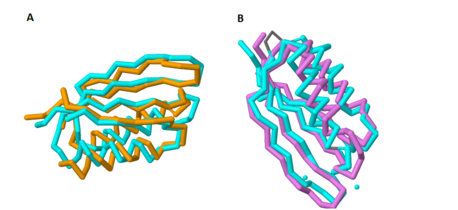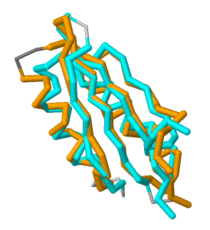Sandbox Reserved 1070
From Proteopedia
(Difference between revisions)
| Line 13: | Line 13: | ||
This domain of MgtC, in contrast, is highly variable in comparison to several orthologs, as presented by Yang ''et al''. However, it is this <scene name='69/698113/Secondary_structured_coloring/2'>tertiary structure</scene> containing two α-helices and four anti-parallel β-sheets that is incredibly indicative of the MgtC super family. Through a sequence alignment of five known functional MgtC orthologs from [http://en.wikipedia.org/wiki/Pathogen pathogens] that survive inside [http://en.wikipedia.org/wiki/Macrophage macrophages] (''M. tuberculosis, [http://en.wikipedia.org/wiki/Brucella_melitensis B. melitensis], [http://en.wikipedia.org/wiki/Burkholderia_cenocepacia B. cenocepacia], [http://en.wikipedia.org/wiki/Yersinia_pestis Y. pestis],'' and ''[http://en.wikipedia.org/wiki/Salmonella_enterica_subsp._enterica S. Typhimurium]''), seven strictly conserved residues were found to be scattered along the whole sequence of the relatively hydrophilic and soluble C-terminal domain. <ref name="mgtc"/> | This domain of MgtC, in contrast, is highly variable in comparison to several orthologs, as presented by Yang ''et al''. However, it is this <scene name='69/698113/Secondary_structured_coloring/2'>tertiary structure</scene> containing two α-helices and four anti-parallel β-sheets that is incredibly indicative of the MgtC super family. Through a sequence alignment of five known functional MgtC orthologs from [http://en.wikipedia.org/wiki/Pathogen pathogens] that survive inside [http://en.wikipedia.org/wiki/Macrophage macrophages] (''M. tuberculosis, [http://en.wikipedia.org/wiki/Brucella_melitensis B. melitensis], [http://en.wikipedia.org/wiki/Burkholderia_cenocepacia B. cenocepacia], [http://en.wikipedia.org/wiki/Yersinia_pestis Y. pestis],'' and ''[http://en.wikipedia.org/wiki/Salmonella_enterica_subsp._enterica S. Typhimurium]''), seven strictly conserved residues were found to be scattered along the whole sequence of the relatively hydrophilic and soluble C-terminal domain. <ref name="mgtc"/> | ||
| - | A large hydrophobic core has conserved residues <scene name='69/698113/ | + | A large hydrophobic core has conserved residues <scene name='69/698113/Colored_core_residues/6'>Cysteine-155, Arginine-164, Glutamine-160, and Alanine-195</scene>. |
[[Image:Final_Final_Core_Logo.PNG |625× 116px|thumb|left|Four strictly conserved residues of five known functional MgtC orthologs of the soluble C-terminal domain. | [[Image:Final_Final_Core_Logo.PNG |625× 116px|thumb|left|Four strictly conserved residues of five known functional MgtC orthologs of the soluble C-terminal domain. | ||
| Line 33: | Line 33: | ||
| - | The opposite side of the protein has a small cluster of conserved residues <scene name='69/698113/Conserved_surface_residues/ | + | The opposite side of the protein has a small cluster of conserved residues <scene name='69/698113/Conserved_surface_residues/6'>Tyrosine-149, Glutamine-208, and Tryptophan-225</scene>. |
[[Image:Final_Surface_Web_Logo.PNG |625× 121px|thumb|left|Four strictly conserved residues of five known functional MgtC orthologs of the soluble C-terminal domain.The figure was prepared using WebLogo. (http://weblogo.berkeley.edu/)]] | [[Image:Final_Surface_Web_Logo.PNG |625× 121px|thumb|left|Four strictly conserved residues of five known functional MgtC orthologs of the soluble C-terminal domain.The figure was prepared using WebLogo. (http://weblogo.berkeley.edu/)]] | ||
Revision as of 21:35, 17 April 2015
| This Sandbox is Reserved from 02/09/2015, through 05/31/2016 for use in the course "CH462: Biochemistry 2" taught by Geoffrey C. Hoops at the Butler University. This reservation includes Sandbox Reserved 1051 through Sandbox Reserved 1080. |
To get started:
More help: Help:Editing |
MgtC: A Virulence Factor From Mycobacterium tuberculosis
| |||||||||||
References
- ↑ Singh, G.; Singh, G.; Jadeja, D.; Kaur, J. Lipid hydrolyzing enzymes in virulence: Mycobacterium tuberculosis as a model system. Critical Reviews in Microbiology 2010, 36(3): 259-269. DOI: 10.3109/1040841X.2010.482923.
- ↑ 2.00 2.01 2.02 2.03 2.04 2.05 2.06 2.07 2.08 2.09 2.10 Yang, Y.; Labesse, G.; Carrere-Kremer, S.; Esteves, K.; Kremer, L.; Cohen-Gonsaud, M.; Blanc-Potard, A. The C-terminal domain of the virulence factor mgtc is a divergent act domain. J Bacteriol. 2012, 194(22): 6255-6263. DOI: 10.1128/JB.01424-12.
- ↑ Blanc-Potard, A.B.; Lafay, B. MgtC as a horizontally-acquired virulence factor of intracellular bacterial pathogens : evidence from molecular phylogeny and comparative genomics. J Mol Evol. 2003, 57(4): 479-86. DOI: 10.1007/s00239-003-2496-4
- ↑ Belon, C.; Gannoun-Zaki, L.; Lutfalla, G.; Kremer, L.; Blanc-Potard, A.B. Mycobacterium marinum mgtc plays a role in phagocytosis but is dispensable for intracellular multiplication. Plos One 2014, 1-23. DOI: 10.1371/journal.pone.0116052.
- ↑ 5.0 5.1 5.2 Jean-Francois, F.L.; Dai, J.; Yu, L. ; Myrick, A. ; Rubin, E. ; et al. Binding of mgtr, a salmonella transmembrane regulatory peptide, to mgtc, a mycobacterium tuberculosis virulence factor: a structural study. DOI:10.1016/j.jmb.2013.10.014




